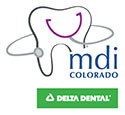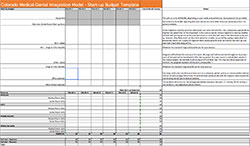
Developing a CO MDI Model Budget
This section guides you through many of the key pieces to creating a CO MDI model budget and provides a budgeting template. The CO MDI model budget template walks you through five topics that are important for developing a budget specific to this model. Although not included in the budget, you may want to consider adding a practice transformation or quality improvement coach to your project expenses if you don’t already have those resources on staff.
Funding your CO MDI Model Work
Funding for startup and implementation of the CO MDI model could come from your own practice or through other revenue streams such as grants. Typically, there is little or no revenue generated in the six-month startup phase. Revenue usually begins to be generated in the implementation phase. Expect revenue to be slow at first and increase over time as your model is established.
Budget Categories
Expenses:
Expenses are categorized into two groups: 1) personnel and 2) non-personnel.
- Non-personnel expenses include equipment, dental record software, consumables that are used once and repurchased on an ongoing basis, and other variables.
- Personnel expenses include the salary and benefits of the dental hygienist and any other personnel whose time and effort are spent on the project. This could be support staff such as a dental assistant, and/or a percentage of the salary/fringe benefits for an administrative supervisor and project champion.
| Expenses | |
|---|---|
| NON-PERSONNEL EXPENSES | |
| Equipment | The equipment you need may vary based on the services your hygienist provides. What services are provided will depend on the characteristics of your practice’s patient population (e.g. age, disease), degree of supervision available to the hygienist, and where services are delivered (medical room, dental room, between rooms and/or between practice sites). A description of typical equipment and related costs is included in the sample equipment list document. We recommend using a dental hygiene professional to help plan your equipment purchases. For additional information, see the Equipment page. |
| Consumables | Consumables are disposable items that are typically used once and then regularly repurchased. The costs of consumables will vary greatly by vendor, services provided, dental hygiene practice style, and preferences. A list of typical consumables is included in this equipment list document. |
| Electronic Dental Record Software | Multiple electronic dental record software options are available. Each has different features and functionality to consider. For more detailed information, see section Electronic Dental Record Interfacing with Electronic Medical Record. A few considerations include:
|
| PERSONNEL EXPENSES | |
| Salary/Benefits of Hygienist | Hygienists’ salaries in Colorado typically range from $60,000 - $85,000 annually (excluding benefits) for those working full time. Factors that impact compensation include location and experience. |
| Salary/Fringe Benefits of Other Staff | Other staff in the practice will spend time working on this project. If these staff members invest substantial time, you may want to include expenses to cover their efforts in the budget. Staff to consider including may be the hygienist’s direct supervisor, a project champion, or dental hygiene support staff (such as a dental assistant). |
| Other | Other costs to consider include: hygienist malpractice insurance; translation costs; additional internet resources; computer or other device (consider desired mobility of hygienist when deciding between desktop, laptop, tablet, etc.); phones and communications; marketing and printing; mileage, training, and conferences costs; laundry (OSHA doesn’t allow hygienists to wash their uniforms at home); equipment maintenance and replacement; and construction. |
Revenue:
Calculating the potential revenue generated by your CO MDI model can be done several ways. In this toolkit, we only discuss revenue generated by integrated dental hygiene services provided in the medical side of the practice.
| Revenue | |
|---|---|
| # of dental hygiene visits/day (or month) | A traditional dental hygiene visit in a dental chair ranges from 30 minutes to one hour. Visits with children require less time. Screenings, education, and fluoride varnish in the medical exam room require about eight minutes each. An estimate of the number of minutes needed to complete a procedure can be found here. The hygienist’s schedule should include new and recall patient visits in the dental chair, going into medical rooms, and the flexibility to accept warm handoffs from the medical providers. In our experience with the CO MDI Project, the majority of practices aimed for eight to 10 dental hygiene visits/day, of varied length. |
| Dental hygiene procedures provided at visit | The procedures indicated at each visit will depend on the patient’s needs. For example:
|
| Reimbursement for dental procedures | There are many types of dental benefits, depending on the patient's specific plan. Learn more details regarding this on the Billing page. Currently in Colorado, Medicaid includes a dental benefit for children and adults. Emergency Medicaid does not include a dental benefit, nor does traditional Medicare. CHP+ has a dental benefit. FQHCs will be paid based on encounter rate, versus other types of safety net clinics that will be paid fee-for-service. |
| Payer (Insurance) Mix | Your overall payer mix will inform your budget. And, if your practice’s patients don’t have dental insurance, consider accepting a sliding fee scale or another self-pay option. |
| Realization Rate | A realization rate is what your practice actually collects from insurance companies or patients for services provided, versus the amounts you bill. If your practice already provides dental care, ask your finance department what your realization rate is for dental hygiene visits. If your practice doesn’t provide dental care, you will have to estimate this. The realization rate of your medical visits is a good place to start. There are number of reasons why practices don’t collect 100% of what they could. Here are some examples:
|
Factors Contributing to Financial Success
If your practice is struggling with financial sustainability after you implement your medical-dental integration work, the following factors may play a role:
- Staffing: It is important to choose a hygienist that is a good fit for the job. Also, a hygienist that is working full time (.8-1.0 FTE) will be available during the majority of business hours, which will increase patient use of dental services.
- Patient Volume: The busier your medical practice is, the more opportunities your hygienist will have to meet a patient who needs services.
-
TIPThe patient’s family members are also potential patients. When visiting with a patient who has the scheduled visit, also look into the needs of other family members in the room (or at home).
- Target Populations: You may want your hygienist to target a specific patient population (e.g. children, pregnant women, diabetics). If your hygienist isn’t busy enough, consider expanding their services to other patients, even if it ends up being any patient in your practice without a dental home.
- Workflows: The better your practice’s workflows and processes, the more likely a patient will be identified as needing your hygienist’s services.
- Missed Opportunities: Is your workflow built to capture every opportunity to get medical patients to see the hygienist? Is it being implemented as designed? Most likely it will require multiple tests and revisions as you identify missed opportunities. See these sections for tips on practice transformation, developing and refining workflows, and missed opportunities.
- Billing: Check to see if the services of your hygienist are being billed correctly and whether denied claims are being resolved. Use an outside, objective billing consultant, if possible. Practices with or without dental billing experience often face unanticipated problems being reimbursed for care delivered and optimizing their realization rates.

